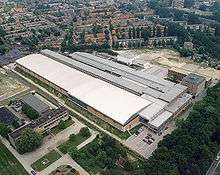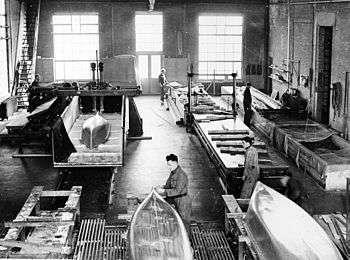Maritime Research Institute Netherlands
MARIN, the Maritime Research Institute Netherlands, is one of the leading institutes in the world for hydrodynamic research and maritime technology. The services incorporate a unique combination of simulation, model testing, full-scale measurements and training programmes.[1] MARIN provides services to the shipbuilding and offshore industry and governments. Customers include commercial ship builders, fleet owners, naval architects, classification societies, oil and LNG companies and navies all over the world.
In the Netherlands MARIN has the status of Great Technological Institute, thus linking science and applied knowledge. Results from fundamental research are directly integrated in applications for clients. Over 85% of the turnover is realised by commercial projects for the international maritime industry. The remaining 15% is derived from scientific research.

Offices
MARIN’s head office is in Wageningen with two more offices in Ede and Houston. MARIN has 350 employees, seven test facilities and three simulators.
History

History goes back as far as 1873, when the first model tests in the Netherlands were carried out. Bruno Tideman, senior engineer in the Navy and advisor for the ship building industry, carried out tests with marine cruiser Atjeh, to define the resistance and the required engine power. When in 1922, after the great economic depression, the ship building industry recovered, the first towing tank was built. This project was realised thanks to contributions from several parties. The Stoomvaart Maatschappij Nederland (Steam liners Company), Royal Rotterdam Lloyd, Royal Packet Boat Service and Nederlands-Indische Tankstoomboot-Maatschappij (Dutch-Indies Tank steamers) were prepared to pay half the foundation costs. The remaining 350,000 Dutch guilders were paid by the Dutch government. This was the start of the NSP (Dutch Shipbuilding Testing Facility Foundation), the basis of today’s MARIN.
In April 1932 the NSP was put into operation. After the Towing Tank (today’s Deepwater Tank) was filled with water, the first towing tests were carried out. On 9 May 1932 the NSP was officially opened, disposing of one towing tank, a model production facility. At the time there were no permanent employees. In that first year, 1932, the number of orders booked was far higher than expected, 25,000 Dutch guilders (11,360 Euro); which is a good result seen against the 30,000 guilders' cost of exploitation. This favourable result was continued in the following years. By 1938 the number of employees had grown to 36, which required an extension of the number of offices. The demand for model tests grew steadily and in 1941 led to the construction of a large cavitation tunnel for the research into propeller cavitation. In 1952 another extension was necessary. The Deepwater Tank was extended by 92 m to 252 m and the design department was increased considerably.
In the 1950s and 1960s some more extensions were necessary. The great demand for specialist research required the building of more sophisticated test facilities. The first one was the Seakeeping Basin (1956) for research into ship behaviour in waves. Next came the Shallow Water Basin (1958), for tug boats, inland shipping and merchandise shipping in shallow water. In 1965 a High Speed Basin and a Wave and Current Basin were put in operation. In the High Speed Basin tests are carried out with ship models or appendages that are propelled at very high speeds. In the Wave and Current Basin (today’s Offshore Basin) wind, current and waves are simulated for research into the behaviour of structures during complex operations at sea, such as the oil and gas production and dredging operations. In 1970 the Manoeuvring Simulator was built to find solutions for ever more complex manoeuvring operations and because of increased interest in the relation between man and ship. In 1972 the institute was further extended with a Vacuum Tank at Ede for the research into problems caused by propeller cavitation. In 1980 NSP and NMI (Rotterdam) decided to merge, which was the beginning of the Maritime Research Institute Netherlands, MARIN. The latest extension was the Vessel Traffic Service simulator, where VTS operators are trained. In 2000 and 2001 the institute was again thoroughly updated. The former Seakeeping Basin and Wave and Current Basin were replaced by a new Seakeeping and Manoeuvring Basin and a new Offshore Basin. Moreover, the Vacuum Tank was completely renovated. In 2012 flap type wave maker were added on two sides of vacuum tank which is now called depressurized towing tank (DWB).